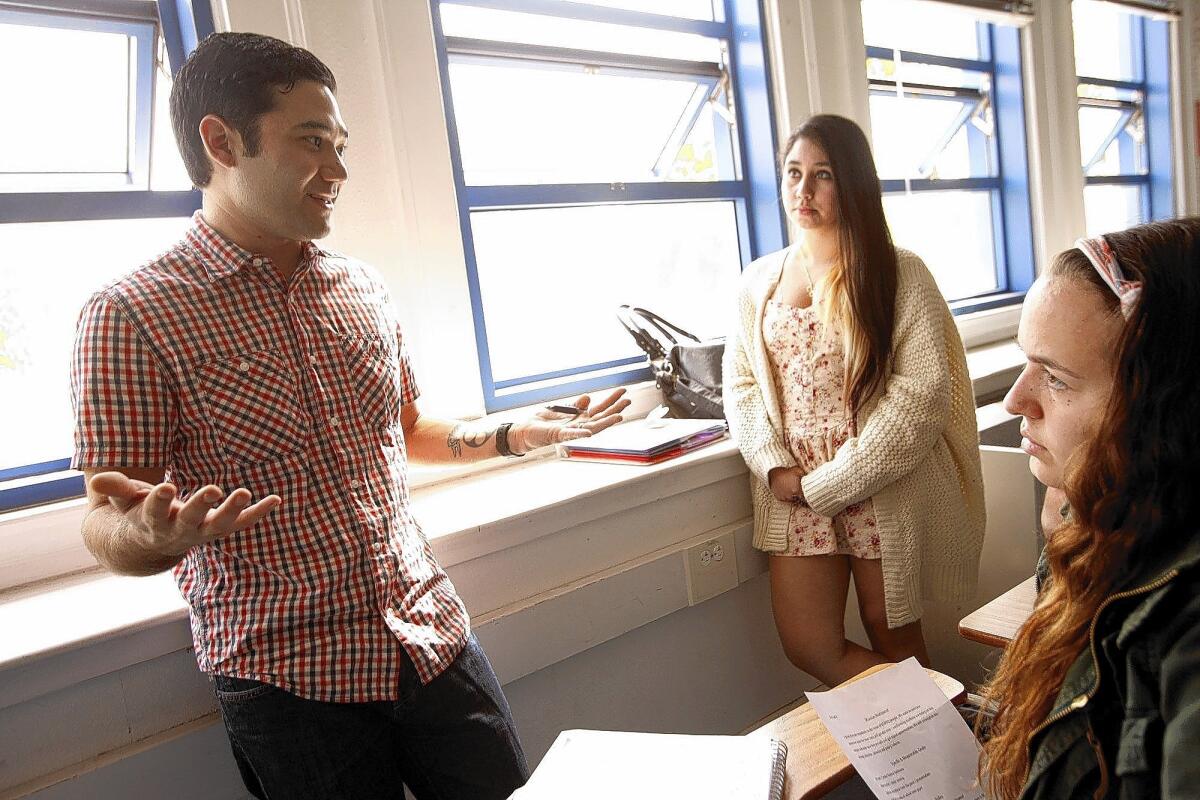Standardized ethnic-studies curriculum for high schools to be studied

Students in Santa Monica High School’s ethnic-studies class took on a touchy subject recently when they analyzed enrollment in Advanced Placement courses. Despite the school’s diversity, most of those taking the college-level classes were predominantly white and from affluent backgrounds, the students found.
Their findings didn’t come as a complete surprise. The students had studied racism in education and housing, and they suspected that all ethnicities wouldn’t be equally represented. The next step was to find a way to change it.
The AP survey was a real-life lesson in ethnic studies, an approach that teacher Kitaro Webb said exemplifies the goal of the program. That is, to create bridges between people and spur students to become active participants in the world around them, Webb said.
“The whole point of ethnic studies is American at its core,” he said. “It’s about civic engagement, responsibility and fighting for what you believe in.”
It’s exactly this kind of course that California lawmakers are hoping to replicate throughout the state. A bill approved last week by the state Assembly requires the Education Department to form a task force to study how best to implement a standardized ethnic-studies curriculum in high schools statewide. The legislation now is in the Senate.
It is a deliberately modest first step to give experts time to analyze the most effective curriculum, said Assemblyman Luis Alejo (D-Watsonville), who sponsored the measure.
The effort has so far avoided the clashes over mandatory ethnic-studies classes seen elsewhere. In 2011, Arizona outlawed a popular Mexican American studies program in Tucson public schools. The law bans classes primarily designed for a particular ethnic group or those that “promote resentment toward a race or class of people.”
And a movement to require Mexican American courses in Texas recently failed.
“California is moving in a different direction, one that recognizes and values the history of the people who make up our state,” Alejo said. “This will put California on the cutting edge — while other states are trying to abolish ethnic studies, we can standardize and incorporate it into high school curriculum.”
Opponents of ethnic-studies classes say they are divisive and foster resentment among students.
Supporters say the classes teach students about long-neglected slices of America’s cultural heritage by exploring different perspectives in literature, history and social justice.
About three-quarters of the 6.2 million public school students in California are nonwhite. Latinos make up 53% of state enrollment.
“We’re trying to incorporate the histories and knowledge of different communities that make up our state — not limited to communities of color,” Alejo said. “Ethnic studies should be seen not just as Latino — but Irish, Jewish, Filipino — there is no limitation.”
Alejo envisions lessons tailored to different communities, similar to the classes he took at a community college near his hometown of Watsonville, Calif. There, he studied the plight of his relatives, migrant workers who picked grapes and worked in the orchards outside Fresno. He also studied the struggle of Filipino workers.
“I learned that many of our histories are interwoven,” said Alejo, who has a bachelor’s degree in Chicano studies from UC Berkeley.
A revision of California academic standards, which must be approved by the state Board of Education or directed by the Legislature, could cost school districts millions of dollars because it would probably require new courses, staff and materials, according to an analysis by the Assembly Appropriations Committee. Alejo said the task force would make recommendations on how to infuse multicultural material into existing high school courses.
Still, lawmakers believe the governor would support the legislation. (A similar bill was vetoed in 2002 by then-Gov. Gray Davis.)
In recent years, ethnic-studies programs on California college campuses have been hit by budget cuts; professor positions have been unfilled, class offerings and majors reduced, eliminated or folded into other programs. Most UC campuses and other universities, however, require undergraduates to take a class in racial, cultural, gender or religious diversity.
Many voluntary classes exist in school systems across the state. In 2013, about 100 schools offered 435 ethnic-studies courses, and about 4,380 students enrolled in them, according to the Education Department.
San Francisco Unified offers five ethnic-studies courses, including Defining Racism and Reconstruction to Jim Crow, at four high schools.
“What ethnic studies is really about is creating opportunity for young people to learn about themselves and the world around them and make the world a better place,” said Allyson Tintiangco-Cubales, an ethnic studies professor at San Francisco State who helped develop the courses. “That sounds hokey, but ultimately that’s what it’s about.”
On a recent morning at Santa Monica High, students rehearsed presentations to the school board on their ethnic-studies class.
One group explained their campaign lobbying for a gender-neutral restroom on campus for students. A few days later, the principal agreed to create one.
The group that studied the ethnic and geographic enrollment in AP courses presented their findings to classes of freshmen to encourage them to take more of the college-level classes. The students plan to present their study to school counselors.
Senior Thomas Musca, 18, was raised in the more affluent area of town. He said the project has helped put historical events and his own city into perspective.
“It increases your empathy toward others,” he said. “You can put yourself in their shoes a little bit and you can maybe get an inkling of what it was like and see how you should really treat everyone equally.”
More to Read
Sign up for Essential California
The most important California stories and recommendations in your inbox every morning.
You may occasionally receive promotional content from the Los Angeles Times.











